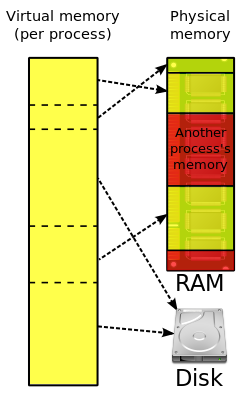UTPA STEM/CBI Courses/Microprocessor Systems/Microprocessor System Design
Course Title: Microprocessor System Design
Lecture Topic: Cache Memory Design
Instructor: Dr. Yul Chu
Institution: University of Texas - Pan American
Backwards Design
[edit | edit source]Course Objectives
- Primary Objectives- By the next class period students will be able to:

- Sub Objectives- The objectives will require that students be able to:
- Understand how the read memory operation works.
- Understand how the write memory operation works.
- Difficulties- Students may have difficulty:
- To understand how to access cache memory with memory address.
- To understand how to replace the block data from memory to cache memory.

- Real-World Contexts- There are many ways that students can use this material in the real-world, such as:
- Intel x86 CISC microprocessor
- MIPS 2000 RISC processor
Model of Knowledge
- Concept Map
- Determining a cache size
- Determining a block size
- Understanding mapping functions
- Understanding replacement policies
- Understanding write policies
- Content Priorities
- Enduring Understanding
- Direct-mapped, n-way set-associative, and fully associative
- Least Recently Used (LRU), Most Recently Used (MRU), and Random replacement policies
- Write-Back/Write-Allocate and Write-Through/Write-No-Allocate policies
- Important to Do and Know
- How to access cache memory with index part of memory address.
- How to replace a cache line based on dirty bit info.
- The concept of block data and byte offset is ?
- Worth Being Familiar with
- Understanding cache memory and memory locations
- Computing average memory access time
- Understanding block address and data in cache memory
- Enduring Understanding
Assessment of Learning
- Formative Assessment
- In Class (groups)
- Let each group (3 to 4 students/group) design a cache memory and discuss it.
- Let each group check the five factors for a cache memory and verify it.
- Homework (individual)
- To implement some memory references manually.
- To compute average memory access time for direct-mapped and n-way set-associative cache memory.
- In Class (groups)
- Summative Assessment
- Let each group design a cache memory (4-way set-associative) and implement several read and write operations.
- Final Exam
Legacy Cycle
[edit | edit source]OBJECTIVE
By the next class period, students will be able to:
- Understand how the read memory operation works
- Understand how the write memory operation works.
- Understand why the temporal and spatial localities are important to design a cache memory.
The objectives will require that students be able to:
- Understand memory hierarchy.
- Understand physical memory and virtual memory.

The program thinks it has a large range of contiguous addresses; but in reality the parts it is currently using are scattered around memory (RAM), and the inactive parts are saved in a disk file. - Understand how the mapping function works.
- Understand how the replacement policy works.
- Understand how the writing policy works.
THE CHALLENGE
How to design cache memory to reduce cache misses for a small L1 cache to improve system performance?
GENERATE IDEAS
How to design a cache memory using localities?
MULTIPLE PERSPECTIVES
How to implement 'write hit and miss policies'? How to implement 'LRU replacement policy for 2-way or 4-way set-associative cache memories'? How to update the cache memory for a write-back? How to access a cache memory from processor?
RESEARCH & REVISE
-Read lecture notes, textbook, and papers. -group discussion. -do manual implementation and revise any errors.
TEST YOUR METTLE
- Formative assessment: Small quizzes, concept quizzes, and discussion.
- Summative Assessment: Projects and exam.
GO PUBLIC
Final presentation, report, grading, and verification test.
Pre-Lesson Quiz
[edit | edit source]- What is the purpose of cache memory?
- Is it possible to access cache memory with memory address? If yes, how?
- What does SRAM stand for?
- What does RAM stand for?
- Which one is more expensive, RAM or SRAM ?
- What is L1 (Level One) cache?
- What is Temporal Locality?
- Explain Fetch-Execute cycle.
- Explain the differences between RISC and CISC.
- What is Spatial Locality?
Test Your Mettle Quiz
[edit | edit source]- Why the performance of 2-way set-associative has better performance than direct-mapped cache?
- Which of the following replacement policies is popular and why? 1) LRU 2)MRU 3) Random
- For a small cache memory, which of the following cache misses is critical to performance? 1) Conflict miss 2) Compulsory miss 3) Capacity miss
- What kind of write-miss policy can work with write-back hit policy?
- List 5 factors to design cache memory.
- List three steps to determine cache miss or hit?
- What is memory hierarchy?
- Explain physical address and virtual address in brief.
- What are the benefits of the virtual address?
- If the size of a direct-mapped cache memory is 8KB and the block size is 64 bytes, then how many bits for cache indexing are needed?


